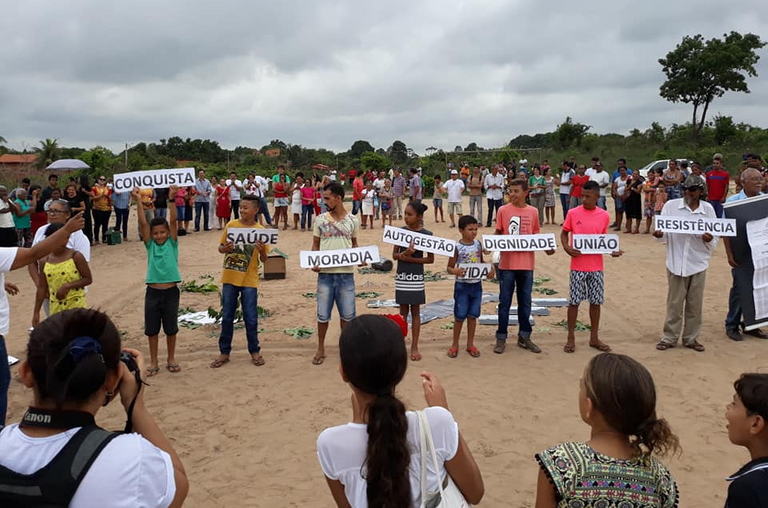Brazil: indigenous people against mining industries
Carajàs is considered the largest open cast iron mine in the world, in the heart of the Amazon. After over twenty years of battles, the first families of the suburb of Açailândia will be able to settle in a new territory, safe from poisonous fumes. But the pollution does not stop.
The mining industry, the wild deforestation that has devastated the Amazon forest for decades, cattle farming and soybean monoculture, have been the main sources of exploitation in Brazil for decades, often with the connivance of the government, in the vast country will hold presidential elections next October 2, with domestic or foreign multinationals being the main players.
The price that the populations allocated in the mining areas pay is very high, the loss of health of thousands of people due to the pollution caused, in fact, by industries that operate indiscriminately, without guaranteeing the necessary protection to the inhabitants.
One of the areas of the country most directly affected by this policy of wild extraction is in the state of Maranhão, and concerns the community of Piquià de Baixo, a suburb of Açailândia. Now, after more than twenty years of claims for the reparation of the violations suffered, the inhabitants of the slum have obtained the right to resettlement in a new neighborhood, sufficiently far from the toxic fumes, called Piquià da Conquista.
The story began in 1987; at that time the iron and steel industry settled around Piquià with five cast iron factories, a railway and other mining company facilities. Since then, the presence of Vale Industries Ltd and the steel industries has been consolidated, and the population living close to them experiences the damage of toxic miasmas on their own skin.
Over the years, mining operations have increased and today Carajàs is considered the largest open cast iron mine in the world, in the heart of the Amazon. The huge iron and steel mining activities, the production of cement and the steel mills have contaminated the air and in general the environment of this region with a strong impact on the health of the community, as has been shown by precise scientific studies.
The only solution, at one point, was the abandonment of the area and the displacement of people to another place, once the causal link between the damage to health observed in the population, respiratory disorders and other diseases, and the very high levels of pollution.
This conclusion was reached by a study based on the collection of data and the recording of the subjects' medical history through questionnaires, focusing on cardiovascular and respiratory diseases, with evaluation through spirometric tests.
The research found that almost 30% of the population analyzed had a significant respiratory deficit; a percentage up to six times higher than that of the rest of the inhabitants of Brazil.
The campaign 'An invitation to Piquià de Baixo', which the inhabitants of the suburb conducted together with Fidh, had the objective of denouncing the pollution produced by the mining companies operating there, such as Vale and Grupo Ferroeste.
From the beginning, the demands of the Piquià community have been supported by local associations, such as the Carmen Bascaràn Center for the Defense of Life and Human Rights, the human rights organization Justiça nos Trilhos and by Comboni Missionaries. As a result 312 families will be able to settle in the new territory of Piquià da Conquista in a short time, safe from poisonous fumes.
Failing to move the steel plants and alternatively asking for a substantial reduction of harmful emissions never implemented, the best solution for the people was the request, now approved, to find a new neighborhood 8 km from the polluted area, where to continue living.
It took a lot of struggle and organization of the people for the government and the companies responsible for the pollution to bear all the costs of resettlement.
The new challenge that people are preparing to face concerns compensation for damage to health and the environment. Furthermore, a solution will have to be found for the contaminated area, to prevent other people from occupying the houses in Piquià that will be abandoned by the residents.
References:








Mehn @davideownzall this here is a very serious case 🙁
Indigenous people are the ones suffering injustices the most, and always due to the greed for money, gladly sometimes they win against big corporations
Yes @davideownzall you’re so right to be honest it’s really bad
Check out my older posts, i have written an other one about abuses on masaai, this is very sad too
Wow would love to can you give me a link to the post so I could go check it out
Here it is
https://peakd.com/hive-110786/@davideownzall/tanzania-maasai-tribes-expelled-from-their-lands
You might also be interested in those
https://peakd.com/hive-110786/@davideownzall/the-mine-in-zambia-that-kills-children
https://peakd.com/hive-110786/@davideownzall/land-expropriated-from-natives-in-cameroon-to-build-hotels
Follow me not to miss future articles 🙂 i often post that stuff